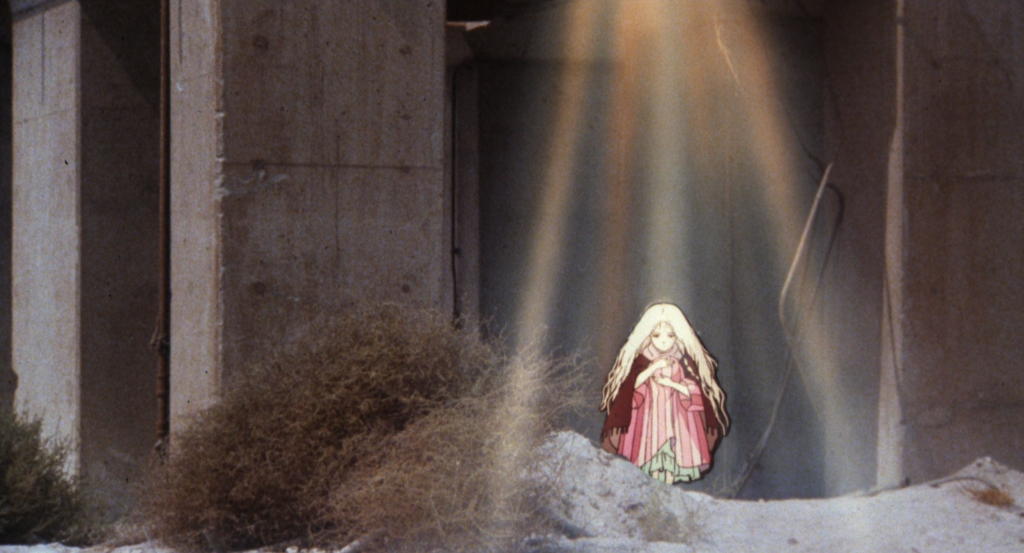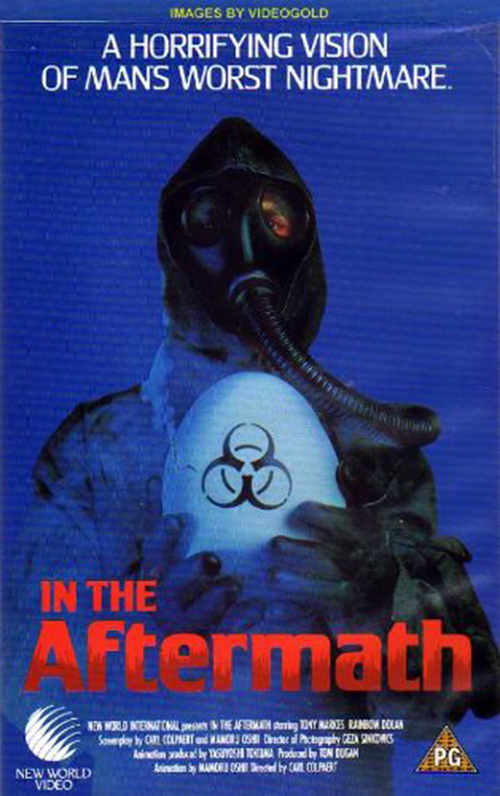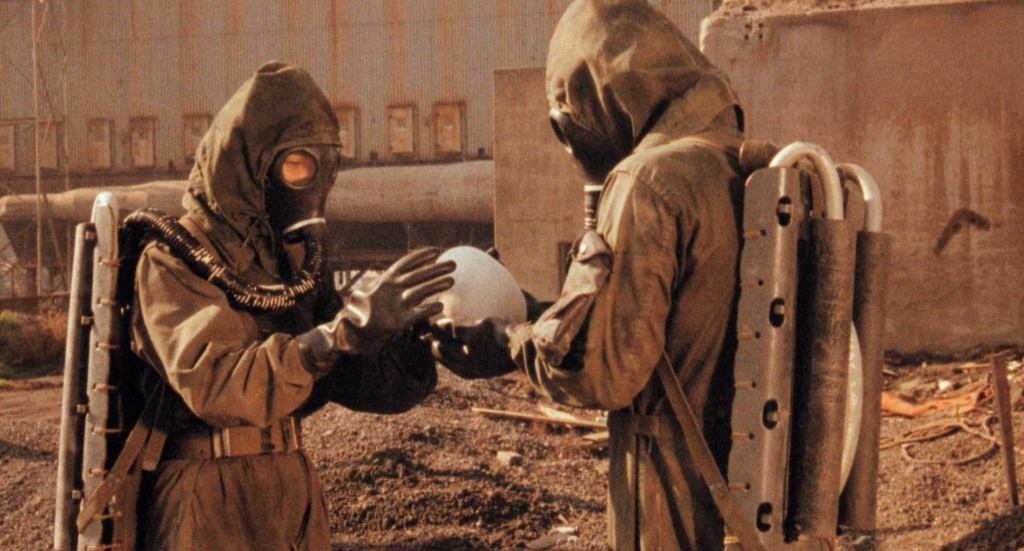
Perhaps the strangest entry in the post-apocalypse genre is In the Aftermath (1988), a hybrid of live action and Japanese anime patched together for the home video market by Roger Corman’s New World Pictures – though it feels like the kind of film you’d encounter randomly at 2 in the morning on a basic cable channel, and wonder the next day if you hadn’t dreamed it. It was recently rescued from obscurity by cult label Arrow Video, and joins the growing ranks of those films one would never, ever have expected to see presented on Blu-Ray. (My personal experience with this title is limited: I recall holding the VHS in my hands in a video store in Salt Lake City, and wondering later if maybe I shouldn’t have rented that bizarre prospect.) In the 80’s, New World had already experimented with anime by acquiring Hayao Miyazaki’s masterpiece Nausicaä of the Valley of the Wind (1984), dubbing and re-editing it as Warriors of the Wind, replete with rip-off Star Wars art (a tape I did rent – my first encounter with Miyazaki, albeit in watered-down form). And a decade before, New World brought the French animated classic Fantastic Planet (1973) to American audiences with minimal meddling. But In the Aftermath was different. The source material was Mamoru Oshii’s Angel’s Egg (Tenshi No Tamago, 1985), a direct-to-video surrealist anime which Corman’s company bought on the cheap. But the bulk of the film is new live action material shot by director Carl Colpaert (Delusion) and producer Tom Dugan. If anyone else were asked to film live action to accompany Angel’s Egg, the result would likely be very different – but Colpaert and Dugan settled on a post-apocalyptic survival story. The result is a film which is actually two films in conversation with one another, and you’d be forgiven if at times you have no idea what they’re actually talking about.
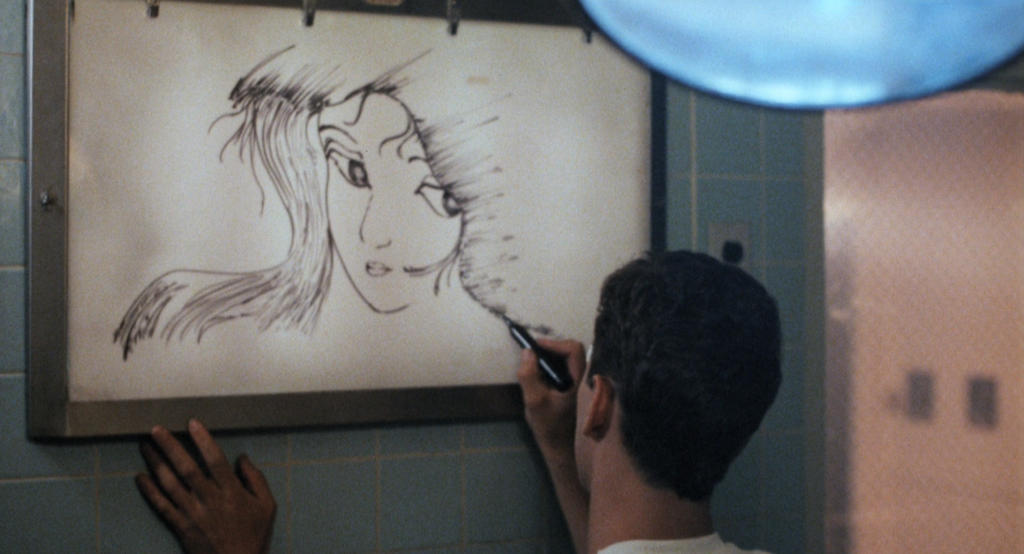
Frank (Tony Markes) draws the girl, Angel, he’s been seeing in visions.
The film opens with an extended, gorgeous passage from Angel’s Egg, as a cathedral of a spaceship descends from the sky upon a ruined city. Angel is a nine-year-old carrying a heavily symbolic egg and given a mission by her enigmatic older brother to deliver the egg to someone deserving. He says things like, “Save only the creatures who will blossom from your energy,” and, unhelpfully, “it’s the duty of all angels to be angels.” She drops a feather onto the ground, which dissolves into a live action feather retrieved by Frank (Tony Markes), a scavenger dressed in a hazmat suit and accompanied by his friend Goose (Kenneth McCabe) in a decimated future Earth. They set out to explore an abandoned military installation on the hunt for clean water and filters for their air purifiers, but they’re set upon by a crazed soldier – Frank’s suit is stolen and Goose is shot dead. Left to breathe the poisoned air, Frank encounters a vision of Angel (played in non-animated form by Rainbow Dolan), and soon finds himself in the empty Green Acres Memorial Hospital under the care of a kind doctor named Sarah (Filiz Tully). Using the hospital’s limited supply of oxygen, they enjoy a temporary paradise – while Frank dreams of Angel’s alternate dimension, and the girl explores the strange sights of the surreal “constellation” she occupies. The two films overlap most effectively in a sequence where Frank dons a gas mask to play piano for Sarah, his melody creating a sensual reverie of images from both movies. The score, incidentally, is very strong, provided by rock musician Anthony Moore (who has collaborated with Pink Floyd, Faust, and Kevin Ayers).
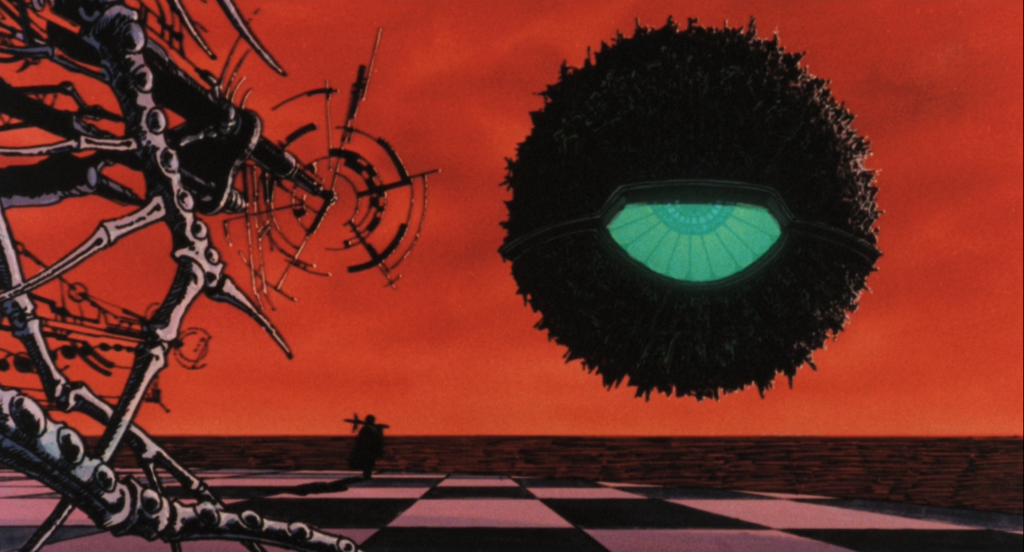
Scenes from Mamoru Oshii’s anime “Angel’s Egg” form a considerable piece of “In the Aftermath.”
Eventually, Frank and Sarah find Angel for a redemptive ending in the live action film; Angel’s own, animated finale is less literal and much more like a fable open to interpretation. In terms of story, that’s about it, though reportedly there’s not much more in Oshii’s original. To straighten the wrinkles in Oshii’s poetic, almost dialogue-free film, Colpaert’s screenplay adds many unnecessary lines and some outright reinterpretations of the material. But the animation is so amazing that it hardly matters, offering little mysteries in each image that no amount of dubbed narration could forfeit. The viewer is left to draw their own conclusions. One wonderful waking dream depicts whalers running through the streets of their empty city throwing harpoons at the shadows of giant invisible fish. The relationship between the floating city and Angel remains somewhat ambiguous, but deeply evocative. If there is a shortcoming to Arrow’s disc, it’s that we can’t watch Angel’s Egg on its own, rights issues being what they are. If we could, it’s likely the low budget, intentionally modest In the Aftermath would become a footnote, which isn’t entirely deserved. Colpaert’s film works as a kind of tone poem. It’s a mood. It’s not like any of the other doomsday films of the 80’s – neither a survivalist action movie nor a gloomy depiction of humanity’s slow demise. Instead, it uses Oshii’s film to introduce fantasy into the poisoned landscape, injecting some “pure air,” this world’s commodity. It ends on a hopeful note. You could argue it butchers Angel’s Egg and New World should have just released the original film intact – and it’s hard to dispute that. Yes, the movie did not need to exist, but as a bizarre remix coming from an unexpectedly soulful place, I’m rather glad it does.
